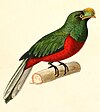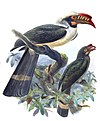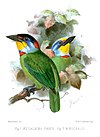|
Genus of birds
Veniliornis is a genus of birds in the woodpecker family Picidae. They are native to the Neotropics.
Taxonomy
The genus was introduced by the French ornithologist Charles Lucien Bonaparte in 1854.[2] The word Veniliornis combines the name of the Roman deity Venilia with the Greek word ornis meaning "bird".[3] The type species was designated as the blood-colored woodpecker (Veniliornis sanguineus) by the English zoologist George Robert Gray in 1855.[4][5]
The genus contains the following 14 species:[6]
| Image |
Common Name |
Scientific name |
Distribution
|
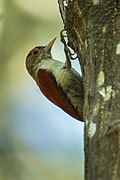 |
Scarlet-backed woodpecker |
Veniliornis callonotus |
Colombia, Ecuador and northern Peru
|
 |
Yellow-vented woodpecker |
Veniliornis dignus |
Colombia, Ecuador, Peru, and Venezuela
|
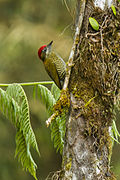 |
Bar-bellied woodpecker |
Veniliornis nigriceps |
Bolivia, Colombia, Ecuador, and Peru.
|
 |
Little woodpecker |
Veniliornis passerinus |
South America east of the Andes
|
 |
Dot-fronted woodpecker |
Veniliornis frontalis |
Argentina and Bolivia.
|
 |
White-spotted woodpecker |
Veniliornis spilogaster |
Brazil, Uruguay, eastern Paraguay and northeastern Argentina.
|
 |
Blood-colored woodpecker |
Veniliornis sanguineus |
Guyana, Suriname, and French Guiana
|
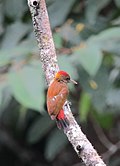 |
Red-rumped woodpecker |
Veniliornis kirkii |
Costa Rica south and east to Ecuador, Venezuela, Trinidad and Tobago
|
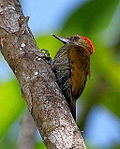 |
Red-stained woodpecker |
Veniliornis affinis |
eastern Brazil and the Amazon Basin.
|
|
Chocó woodpecker |
Veniliornis chocoensis |
Colombia and Ecuador.
|
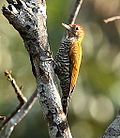 |
Golden-collared woodpecker |
Veniliornis cassini |
northern Brazil, the Guianas, Venezuela and far eastern Colombia.
|
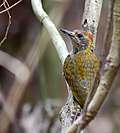 |
Yellow-eared woodpecker |
Veniliornis maculifrons |
eastern Brazil.
|
 |
Striped woodpecker |
Veniliornis lignarius – formerly in Picoides[7][8] |
southwestern South America.
|
 |
Checkered woodpecker |
Veniliornis mixtus – formerly in Picoides[7][8] |
eastern South America.
|
References
- ^ "Picidae". aviansystematics.org. The Trust for Avian Systematics. Retrieved 2023-07-25.
- ^ Bonaparte, Charles Lucien (1854). "Quadro dei volucri zigodattili ossia passeri a piedi scansori". In de Luca, Serafino; Müller, D. (eds.). L'Ateneo Italiano; raccolta di documenti e memorie relative al progresso delle scienze fisiche (in Italian). Vol. 2. Parigi [Paris]: Victor Masson. pp. 116–129 [125].
- ^ Jobling, James A. (2010). The Helm Dictionary of Scientific Bird Names. London: Christopher Helm. pp. 399–400. ISBN 978-1-4081-2501-4.
- ^ Gray, George Robert (1855). Catalogue of the Genera and Subgenera of Birds Contained in the British Museum. London: British Museum. p. 92.
- ^ Dickinson, E.C.; Remsen, J.V. Jr., eds. (2013). The Howard & Moore Complete Checklist of the Birds of the World. Vol. 1: Non-passerines (4th ed.). Eastbourne, UK: Aves Press. p. 318. ISBN 978-0-9568611-0-8.
- ^ Gill, Frank; Donsker, David (eds.). "Woodpeckers". World Bird List Version 6.2. International Ornithologists' Union. Retrieved 5 May 2016.
- ^ a b Donegan, Thomas (January 2007). "Proposal (#262) South American Classification Committee: Transfer Picoides mixtus and P. lignarius to Veniliornis". American Ornithologists' Union. Retrieved 7 May 2016.
- ^ a b Moore, W.S.; Weibel, A.C.; Agius, A. (2006). "Mitochondrial DNA phylogeny of the woodpecker genus Veniliornis (Picidae, Picinae) and related genera implies convergent evolution of plumage patterns". Biological Journal of the Linnean Society. 87 (4): 611–624. doi:10.1111/j.1095-8312.2006.00586.x.
|














